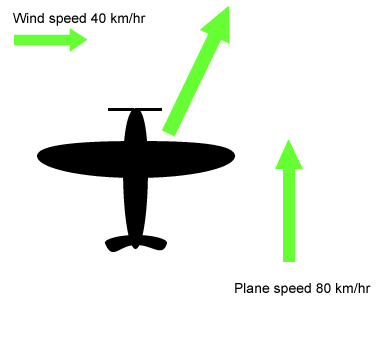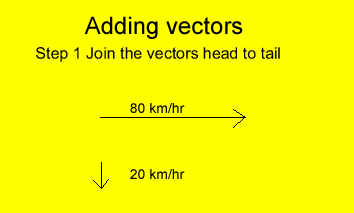Resultant vectors

How do we calculate the magnitude of the resultant vector? Whenever a pair of vectors are at right angles to each other we can use the Pythagorean Theorem to calculate the magnitude of the resultant vector.
A plane travels at a speed of 80 km/hr east and encounters a 20 km/hr cross wind. What is the speed of the plane relative to the ground?
Once again have a look at the animation on the right.


Image from Google
1) A surfer rides along a wave traveling towards the shore at 30 km/hr. The surfer rides along the wave at 40 km/hr parallel to the shore. With what speed is the surfer traveling relative to the shore?
A plane travels south at 40 km/hr. A 20 km/hr westerly wind is acting on the plane. What is the speed of the plane relative to the ground? Solution
An athlete attempting a long jumps runs down the track at 40km/hr before launching himself vertically into the air. What is his speed in the air if he launches himself with a vertical velocity of 20 km/hr? Solution
A plane traveling west at 40
km/hr encounters a wind blowing south at 40 km/hr.
What is the speed of the plane relative to the ground?
In what direction is the plane now traveling?
Solution
Calculate the resultant of
a pair of velocities 80 km/hr north and 60 km/hr west.
Solution
Calculate the magnitude of
the resultant of a horizontal vector with a magnitude of 5 units and a
vertical vector with a magnitude of 3 units.
Solution
Neglecting air resistance,
a bullet leaves the barrel of a gun with a velocity of 400km/hr. It strikes
a target 600m away. Will the bullet strike the target with a velocity
of 400 km/hr, less or greater than 400 km/hr?

Image from Google
The term "Hang time" is used in athletics to describe the length of time an athlete can jump off the ground. In sports such as long-jump hang time is critical. The longer the hang time the greater the distance that the athlete can jump.
At the point the athlete leaves the ground they have a resultant velocity composed of horizontal and vertical velocities at right angles to each other.
Hang time depends on the vertical
or horizontal velocity?
Distance traveled depends on the horizontal or vertical velocity?
Why do athletes seek to increase their horizontal velocity by sprinting down the track before jumping? Solution

Think of:
- tensile force generated in the beam.
- component vectors
Continue with projectile motion